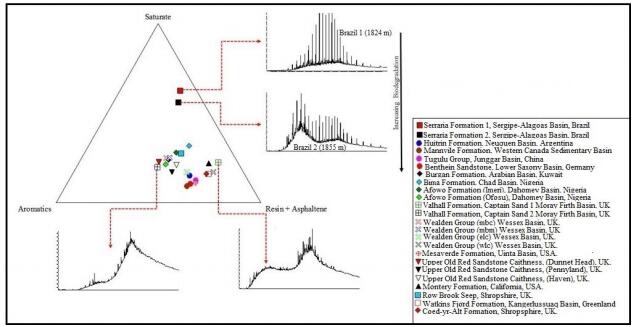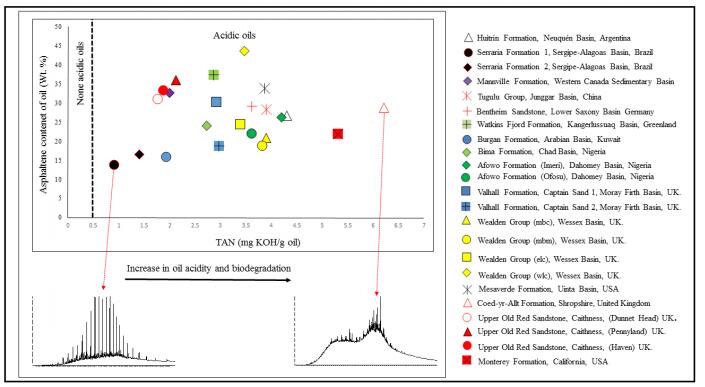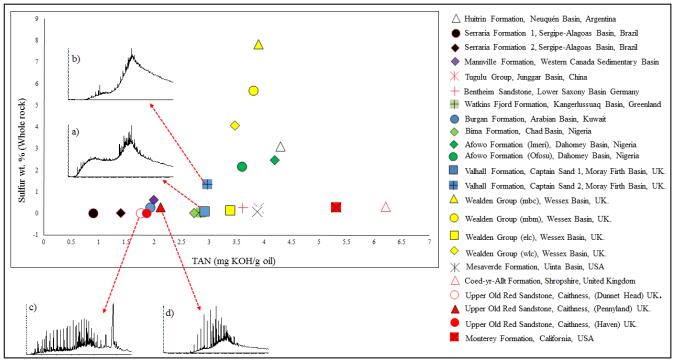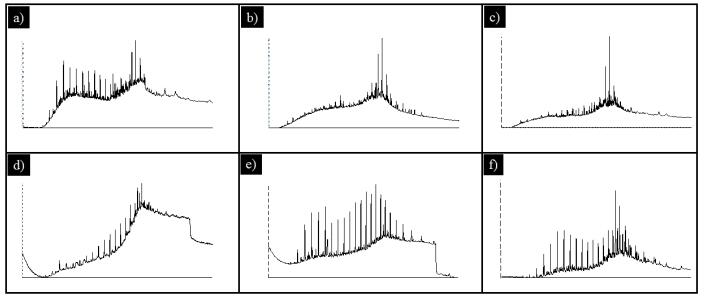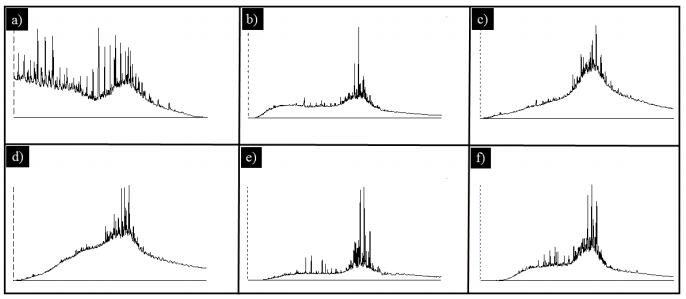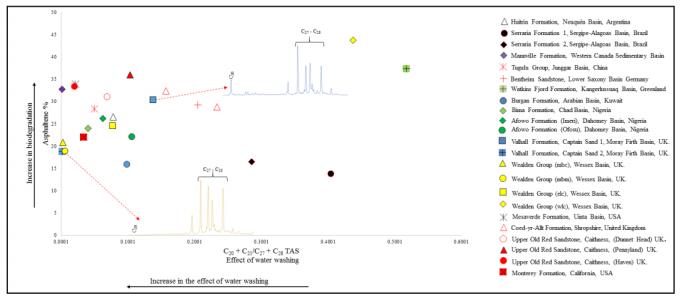1. Introduction
Heavy oils are defined by their high viscosity and high density. Crude oils are classified for economic value according to their API gravity. Light non-degraded oils have API gravities above 36°, heavy oils have API gravities of 20° or less and super-heavy oils have API gravities of 10° or less [1]. Many terms have been used to describe rocks saturated with heavy oil. The most common terms are oil sands, tar sands and bituminous sands.
So many theories have been used to explain the origin of heavy oil. Workers like [2], have reported that a small percentage of heavy oils are generated as immature oils. While this may be true as with oil maturation processes, the generally acceptable view is that heavy oils are generally generated as light oil which later degrades into heavy oil [3,4,5,6]. The two most important processes that act on light oil to produce heavy oil are biodegradation and water washing. These processes occur when certain conditions are met. Petroleum biodegradation requires conditions that support microbial life and it is generally controlled by reservoir temperature, nutrient availability (nitrogen, potassium and phosphorus), oil composition, the oil-water contact area, water salinity, and oil volume in the reservoir [2,6,8].
For petroleum biodegradation to occur the reservoir temperature must be within limits that support life and microorganisms capable of degrading hydrocarbons must be present. Furthermore, there must be sufficient access to petroleum electron acceptors, water with salinity < 100–150 parts per thousand must be present, and the rock fabric must have sufficient porosity and permeability to allow bacterial mobility and diffusion of nutrients [5,6,9]. Reservoir temperature is an important factor that limits biodegradation. Studies have shown that microbial degradation of petroleum is optimal at surface or near-surface temperatures and that it has an upper limit of ~60–80 ℃. At temperatures above 80 ℃, most bacteria cease to metabolise. However, some thermophilic bacteria have been reported to survive at temperatures as high as about 110 ℃ [5,6,9].
The process of biodegradation is primarily a hydrocarbon oxidation process involving the microbial metabolism of various classes of compounds that alters the oil's fluid properties and economic value. More specifically, oil biodegradation typically decreases the API gravity, reduces the content of saturated and aromatic hydrocarbons relative to polar compounds, increases oil viscosity, acidity and sulfur content, and increases the concentration of certain metals in the oil [7]. The residual oils resulting from biodegradation are usually enriched in NSO compounds (resin and asphaltene fractions), sulfur and metals [2,8,9].
One of the main chemical effects of water washing is the removal of the more water-soluble components of petroleum, especially low molecular weight (LMW) aromatic hydrocarbons such as benzene, toluene, ethylbenzene and xylenes (BTEX compounds) [10]. Other important effects of water washing on the composition of crude oil include a reduction in the oil's API gravity, and a reduction in the oil's sulfur, nickel and vanadium contents [11]. Heavy oils are generally believed to have originated as conventional light oils, which were degraded into heavy oils through processes such as biodegradation and water washing. Because water is a necessary ingredient for biodegradation, both biodegradation and water washing are inferred to occur concomitantly. This study is aimed at confirming if the processes of biodegradation and water washing truly occur concurrently. This will be achieved by exploring the effect of biodegradation and water washing on the bulk and molecular properties of oils extracted from various petroleum reservoir sands occurring globally.
2. Method of study
Details of the locations and geologic ages of the studied oil sands are presented in Table 1. Heavy oils occurring in the studied oil sands were solvent-extracted using 93:7 (v/v) dichloromethane and methanol to achieve maximum extraction as described by [4,5,6]. The extracted oils were then separated into saturate, aromatic, and polar fractions using the ASTM D4124 test method described by [12]. The saturate and aromatic fractions were then examined by gas chromatography-mass spectrometry (GC-MS). The GC-MS analysis was carried out using an Agilent 6890N GC fitted with a J & W DB-5 phase 50-m-long column linked to a 5975 MSD and a quadruple mass spectrometer working in selected-ion monitoring (SIM) mode with ionization energy of 70 eV. Samples were injected manually using a split/splitless injector operating in splitless mode (purge 40 ml min−1 for 2 min). The temperature programme for the GC oven was 80–295 ℃, holding at 80 ℃ for 2 min, rising to 10 ℃ min−1 for 8 min and then 3 ℃ min−1 and finally holding the maximum temperature for 10 min. Compounds were identified by comparing retention times to well-characterised materials that served as reference samples.
Table 1. Oil bulk properties and location the studied oil sands.
| S/No |
Country |
Locality |
Stratigraphic name of oil sand |
Geologic age of oil sand |
Saturate
% |
Aromatics
% |
Resin
% |
Asphaltene
% |
Sulfur
Wt. % |
TAN
(mg KOH/g oil) |
Evidence of water washing* |
| 1 |
Argentina |
Neuquén Basin |
Huitrin Formation |
Cretaceous
(Aptian) |
15.3 |
27.1 |
31 |
26.6 |
3.1 |
4.3 |
0.077 |
| 2 |
Brazil |
Sergipe-Alagoas Basin |
Serraria Formation |
Cretaceous
(Berriasian) |
62.7 |
7.9 |
15.6 |
13.8 |
0.002 |
0.9 |
0.403 |
| 3 |
Brazil |
Sergipe-Alagoas Basin |
Serraria Formation |
Cretaceous
(Berriasian) |
56.1 |
12.1 |
15.3 |
16.5 |
0.004 |
1.4 |
0.285 |
| 4 |
Canada |
Western Canadian Sedimentary Basin |
Mannville Group |
Cretaceous
(Albian) |
9.4 |
31.3 |
26.6 |
32.7 |
0.61 |
2 |
0.001 |
| 5 |
China |
Junggar Basin |
Tugulu Group |
Cretaceous
(Cenomanian) |
12.6 |
25.4 |
33.6 |
28.4 |
0.25 |
3.9 |
0.049 |
| 6 |
Germany |
Lower Saxony Basin |
Bentheim Sandstone |
Cretaceous
(Berriasian) |
10.8 |
29 |
31 |
29.2 |
0.25 |
3.62 |
0.204 |
| 7 |
Greenland |
Kangerlussuaq Basin |
Watkins Fjord Formation |
Cretaceous
(Albian) |
16.1 |
17.5 |
29 |
37.4 |
0.025 |
2.86 |
0.517 |
| 8 |
Kuwait |
Arabian Basin |
Burgan Formation |
Cretaceous
(Albian) |
24.1 |
33 |
27 |
15.9 |
0.27 |
1.93 |
0.098 |
| 9 |
Nigeria |
Chad Basin |
Bima Formation |
Cretaceous
(Aptian) |
32 |
19 |
25 |
24 |
0.01 |
2.73 |
0.040 |
| 10 |
Nigeria |
Dahomey Basin
(Imeri) |
Afowo Formation |
Cretaceous
(Turonian) |
28 |
27.3 |
18.5 |
26.2 |
2.47 |
4.2 |
0.062 |
| 11 |
Nigeria |
Dahomey Basin
(Ofosu) |
Afowo Formation |
Cretaceous
(Turonian) |
21.6 |
35.5 |
20.8 |
22.1 |
2.18 |
3.6 |
0.105 |
| 12 |
United Kingdom (UK) |
Western Moray Firth Basin |
Captain sand1 |
Cretaceous
(Aptian) |
22.7 |
9.3 |
37.7 |
30.3 |
0.093 |
2.92 |
0.137 |
| 13 |
United Kingdom (UK) |
Western Moray Firth Basin |
Captain sand2 |
Cretaceous
(Aptian) |
20 |
40.4 |
20.8 |
18.8 |
1.35 |
2.97 |
0.001 |
| 14 |
United Kingdom
(UK) |
Dorset, UK Mupe Bay
(Clast) |
Wealden Group |
Cretaceous
(Valanginian) |
24.9 |
33.7 |
20.6 |
20.8 |
7.82 |
3.90 |
0.002 |
| 15 |
United Kingdom
(UK) |
Dorset, UK Mupe Bay
(Matrix) |
Wealden Group |
Cretaceous
(Valanginian) |
25.2 |
31.8 |
24.1 |
18.9 |
5.68 |
3.81 |
0.005 |
| 16 |
United Kingdom
(UK) |
Dorset, UK East Lulworth Cove |
Wealden Group |
Cretaceous
(Valanginian) |
17.1 |
27.4 |
31 |
24.5 |
0.13 |
3.39 |
0.077 |
| 17 |
United Kingdom
(UK) |
Dorset, UK West Lulworth Cove |
Wealden Group |
Cretaceous
(Valanginian) |
17.3 |
14.4 |
24.6 |
43.7 |
4.07 |
3.47 |
0.437 |
| 18 |
USA |
Near Vernal, Utah |
Mesaverde Formation |
Cretaceous
(Albian) |
11.1 |
26.4 |
28.6 |
33.9 |
0.082 |
3.87 |
0.021 |
| 19 |
United Kingdom
(UK) |
Row Brook, Shropshire |
Coed-yr-Allt Formation |
Carboniferous |
16.4 |
18.2 |
36.6 |
28.8 |
0.31 |
6.21 |
0.233 |
| 20 |
United Kingdom
(UK) |
Pitchford Bridge, Shropshire |
Row Brook
(Seep) |
Carboniferous |
27.6 |
25 |
15 |
32.4 |
- |
6.53 |
0.156 |
| 21 |
United Kingdom
(UK) |
Orcadian Basin (Dunnet Head) |
Upper Old Red Sandstone |
Devonian |
22.9 |
38.2 |
7.8 |
31.1 |
0.012 |
1.76 |
0.068 |
| 22 |
United Kingdom
(UK) |
Orcadian Basin (Pennyland) |
Upper Old Red Sandstone |
Devonian |
17.3 |
34.7 |
12 |
36 |
0.27 |
2.12 |
0.103 |
| 23 |
United Kingdom
(UK) |
Orcadian Basin
(Haven) |
Uphstone |
Devonian |
21 |
30.6 |
15 |
33.4 |
0.021 |
1.87 |
0.019 |
| 24 |
USA |
California |
Monterey Formation |
U. Miocene |
22.1 |
14.3 |
41.6 |
22 |
0.27 |
5.31 |
0.033 |
| *Evidence of water washing was determined by comparing the ratio of C20 and C21 triaromatic steranes relative to their C27 and C28 counterparts on the m/z 231 fragmentogram of the aromatic fractions of the studied oils, as suggested by [11]. |
The ASTMD974-97 test method described by [13] which is a colour titration method was used to determine the total acid number (TAN) of the extracted oils while whole rock total sulfur was determined by combusting about 0.1 g of each powdered oil sand with iron chip accelerator and lecocel ii at temperature above 1000 ℃ in oxygen. Evolved SO2 was detected by infrared absorption using a LECO CS744 analyzer. Evidence of water washing was determined by comparing the ratio of C20 and C21 triaromatic steranes relative to their C27 and C28 counterparts on the m/z 231 fragmentogram of the aromatic fractions of the studied oils, as suggested by [11].
3. Results
3.1. Oil bulk properties and biodegradation
Bulk properties of the heavy oils extracted from the studied oil sands are presented in Table 1. Note that some non-Cretaceous samples were also examined for comparison purposes. The studied oils were depleted in the saturate and aromatic fractions, but enriched in asphaltene and resin fractions, consistent with oils that have undergone biodegradation e.g. [4,5,7]. The varying degrees of biodegradation in the studied oils observed from the oil bulk properties are summarized in the ternary diagram presented in Figure 1. Fragmentograms showing the total ion current (TIC) of the studied oils are also presented in Figures 1 to 5. The TICs show the presence of unresolved complex mixture (UCM) humps. This is a common characteristic of oils that have undergone biodegradation e.g. [4,5,14,15,16,17]. Petroleum biodegradation often results in the progressive depletion of chromatographically resolved hydrocarbons (e.g. n-alkanes, acyclic isoprenoid alkanes; alkyl benzenes, naphthalenes and phenanthrenes) relative to the unresolved hydrocarbon mixture (UCM).
Different effects of biodegradation are observed even amongst oils that are related within the data set considered in this study. For example, in the Brazilian case study highlighted in Figure 1, the effect of biodegradation increased vertically with increasing depth. This is typical of petroleum reservoirs associated with a water-leg. Field observations have shown that in such reservoirs, the lowest oil quality and strongest biological and molecular evidence for hydrocarbon degradation is observed towards the base of the reservoir at oil-water transition zones (OWTZ). Intense petroleum degradation occurs at such transition zones, where the biosphere meets the geosphere, and where microorganisms in the reservoirs find the water necessary for life alongside the electron donors/acceptors and carbon sources available in the oil which are necessary to conserve energy and generate biomass [1,2,4,18,19].
3.2. The total acid number (TAN)
The total acid number (TAN) data of heavy oils extracted from the studied oil sands is also presented in Table 1. TAN, which is a measure of all acidic components, including naphthenic acids and sulfur compounds in oil, is known to increase with an increase in the asphaltene content of oils caused by biodegradation [20]. Biodegradation leads to the formation of naphthenic acid compounds, which increase the acidity of the oil (typically measured as TAN). TAN values in excess of ~0.5 mgKOH/goil are considered to represent highly acidic crude oils. Such oils have a reduced economic value due to production and downstream handling problems such as corrosion and the formation of emulsions [20,21]. There is evidence in the geological record demonstrating that biodegradation is one of the processes that leads to oils having high TAN values [22,23,24,25]. However, the relationship between TAN and biodegradation is very complex since organic acids are also incorporated into oils during source rock maturation [25,26].
A cross-plot of the TAN and asphaltene content of the heavy oils extracted from the studied oil sands is presented in Figure 2. All the studied oils have TAN values greater than 0.5 mg KOH/g oil, consistent with biodegraded oils [9]. The general trend observed in Figure 2 is of an increase in oil TAN values with an increase in the asphaltene content of the oils. The inserted TIC fragmentograms in Figure 2, representing oil with the lowest TAN value in the data set (Serraria Formation 1, from Sergipe-Alagoas Basin, Brazil) and oil with the highest TAN value in the data set (Coed-yr-Allt Formation, from Shropshire, United Kingdom), show an increase in the UCM component with increasing biodegradation. This implies an increase in biodegradation as the oil TAN values increase.
The concentration of sulfur in the studied oil sands varies from 0.002 to 7.82 Wt. % (Table 1). It should be noted that the sulfur values presented in Table 1 would have been considerably higher if measured from the bitumen alone rather than from the generic oil sands (consisting of the bitumens and the non-organic mineral matter in the rocks). A cross-plot of sulfur and oil TAN values for the studied oil sands is presented in Figure 3. The general trend observed in Figure 3 is that oil TAN values increase with the sulfur content. The main source of sulfur in petroleum is the asphaltene fraction, and heavy oils are known to have high asphaltene and sulfur contents owing to the generation of organic sulfur compounds during biodegradation. These processes can be extremely variable, however, depending on access to microbes, water, oxidants and the pasteurizing effects of reservoir temperature [27].
3.3. Water washing
Water washing typically occurs in shallow petroleum reservoirs close to mountain ranges or other elevated terrain, where groundwater at height can drive water flow in the subsurface. Water washing also occurs in zones where microbial activity is precluded by high temperatures and depths. The effect of water washing is difficult to discern in crude oils because biodegradation typically occurs with water washing since water is a necessary ingredient for biodegradation. This makes it difficult to separate the two processes [28,29,30].
One of the main chemical effects of water washing is the removal of the more water-soluble components of petroleum, especially low molecular weight (LMW) aromatic hydrocarbons such as benzene, toluene, ethylbenzene and xylenes (BTEX compounds) [30]. Other important effects of water washing on the composition of crude oil include a reduction in the oil's API gravity, and also a reduction in the oil's sulfur, nickel and vanadium contents [11]. In this study, the effect of water washing was determined by comparing the ratio of C20 + C21 triaromatic steranes relative to their C27 + C28 counterparts on the m/z 231 fragmentogram of the aromatic fractions of the studied oils (Figure 6), as suggested by [11]. Data on the effect of water washing in the studied oils is presented in Table 1. The cross-plot of the effect of water washing and asphaltene content in the data set is presented in Figure 6 and reveals no general trend in the effect of water washing with biodegradation. As expected, water washing is observed to have occurred simultaneously with biodegradation in all the studied oil sands.
4. Discussion
Petroleum biodegradation preferentially removes light components from conventional oil to form heavy oil and bituminous tar sands. Petroleum biodegradation follows a specific order of preference for removing compounds from oils. In addition to biodegradation, oils in petroleum reservoirs are subjected to other possible alteration processes, including water washing, phase separation, gravity segregation and de-asphalting. Typically, biodegradation tends to remove saturated hydrocarbons first in oils, concentrating heavy polar and asphaltene components in the residual oil. This results in increasing viscosity, as well as increasing the sulfur and metal contents of the oils.
The decrease in oil quality due to biodegradation lowers the API gravity of oils, consequently lowering reservoir recovery efficiencies and the economic value of the oil due to decreased refinery extract yields and increased vacuum residue yields (Wenger et al., 2002). It is also possible for some petroleum reservoirs to have a complex history with multiple episodes of oil charge and degradation.
4.1. Oil bulk properties and biodegradation
All the studied oils are enriched in the polar fractions (asphaltene + resin) and depleted in the saturate oil fractions due to biodegradation. Biodegradation increases the asphaltene fraction of the oils by enriching the oils with metal and sulfur compounds. Normal oils generally have asphaltene content of less than 1%. The TIC fragmentograms inserted in Figure 1 showed an increase in asphaltene content with increasing biodegradation within the data set. SEM Edax data for the studied oil sands have demonstrate the occurrence of some metallic compounds/minerals including vanadium, titanium, uraninite and copper sulfide in the studied oil sands [6]. The occurrence of these metallic minerals/compounds in some of the studied oils is believed to have serious consequences for the oil bulk properties, since they serve to increase the polar fractions of the oils, and, in fact, all the studied oils have elevated (acidic) TAN values (TAN > ~0.5 mgKOH/goil, which is considered high).
4.2. The total acid number (TAN) and oil properties
The cross-plot of asphaltene content and TAN values presented in Figure 2 shows TAN values increasing in line with the asphaltene content, most especially amongst oils that are related within the data set. The results presented in Figures 2 and 3, meanwhile, support the hypothesis that biodegradation is a major control of oil TAN. The scattering observed in both Figures 2 and 3 is because some increase in the sulfur content and TAN value of oils can occur due to processes not related to biodegradation. For example, oil source rock type is known to influence the sulfur content of oils, with some high and low sulfur oils having been shown to originate from high and low sulfur kerogens, respectively [9]. Clay-poor carbonate petroleum source rocks contain scarce iron and other metals to scavenge all available sulfide. In such conditions, much of the sulfide is incorporated into the kerogen and oils.
Similarly, metals associated with clay-rich siliciclastic marine sediments usually out-compete organic matter in such rocks for reduced sulfur, leading to low-sulfur kerogen and oils [6,9]. The TIC fragmentograms a and b inserted in Figure 3, representing Valhall Formation, Captain 1 and 2 sands respectively (from the Moray Firth Basin of the United Kingdom), show an increase in the UCM component (which is consistent with an increase in biodegradation) from Captain 1 sand (a) to Captain 2 sand (b) since both sulfur and oil TAN values increase.
Similarly, the TIC fragmentograms c and d inserted in Figure 3 show an increase in the UCM component with a slight increase in sulfur content and TAN values between oils extracted from the Dunnet Head and Pennyland samples of the UORS sands. This implies an increase in biodegradation since both sulfur and oil TAN values increase. It has also been demonstrated in that the UORS sample obtained from Pennyland has relatively more clay minerals compared to the UORS sample obtained from Dunnet Head [6]. The UORS sample obtained from Pennyland is thus more liable to biodegradation due to the readier availability of nutrients from the clay minerals, as described just above.
The data presented in Figures 2 and 3 suggests that the geological and geochemical processes that give rise to high concentrations of sulfur in oils, and high oil TAN values, are those that favour biodegradation, and potentially include moderate reservoir temperatures that can support microbial life (temperature < 80 ℃), and thus the availability of micro-organisms that are capable of degrading oils in the reservoir, and availability of nutrients (e.g., nitrogen, potassium and phosphorus) in the reservoir.
4.3. Effect of water washing on the studied oils
All the studied oils are observed to show evidence of water washing (Table 1; Figure 6). Water is a necessary ingredient for biodegradation; therefore, biodegradation commonly occurs simultaneously with water washing as demonstrated in Figure 6. Water plays many vital roles in petroleum biodegradation including acting as a reactant in biodegradation processes, and also carrying nutrients needed for life. Water also removes inhibitors to biological processes and thus may play the secondary role of controlling life in petroleum reservoirs e.g. [31,32]. There is evidence in the geological record e.g. [18] demonstrating that microorganisms occurring within heavy oil reservoirs are located predominantly near the oil water contacts. This is consistent with the Brazilian and Captain Field case studies presented in this study (Figures 1, 2 and 3) which shows the highest effects of biodegradation near the oil water contact. This implies that water is a necessary component for an actively biodegrading petroleum column. In general, water washing and biodegradation have been accepted by geochemists as a ubiquitous phenomenon wherever crude oil is in contact with oxygen and bacteria-carrying meteoric water e.g. [9,30].
5. Summary and Conclusion
This study explores the effect of biodegradation on oil bulk properties and evidence of water washing in oils extracted from some oil sands. Specifically, this study demonstrates the following:
ⅰ) Oil bulk properties of the studied oils show that all the studied oils are enriched in the polar fractions (asphaltene + resin) and depleted in the saturate oil fractions due to biodegradation.
ⅱ) All the studied oils are acidic, having a TAN > ~0.5 mgKOH/goil, which has a serious negative impact on the economic value of the oils. Such high oil acidity causes production and downstream handling problems such as corrosion and the formation of emulsions.
ⅲ) The geological and geochemical processes that appear to give rise to a high concentration of sulfur in oils, and to oil acidity (typically measured as TAN), are those that favour biodegradation.
ⅳ) Total ion current (TIC) fragmentograms of the studied oils show the presence of significant unresolved complex mixture (UCM) components, which is a common characteristic of oils that have undergone biodegradation.
ⅴ) Water washing is observed to occur simultaneously with biodegradation in all the studied oils.
Acknowledgements
Timothy Bata is thankful to the Petroleum Technology Development Fund of Nigeria for sponsoring his PhD research at the University of Aberdeen, and the management of Abubakar Tafawa Balewa University Bauchi, Nigeria, for permitting him to proceed on study leave. I also acknowledge the British Geological Survey for providing core samples of the Captain Sand used in this study. The Nigerian Geological Survey Agency Akure is also acknowledged for the acknowledge the help and support I received from them during the field work in Dahomey Basin Nigeria.
Conflict of interest
The authors declare no conflict of interest.









 DownLoad:
DownLoad: 